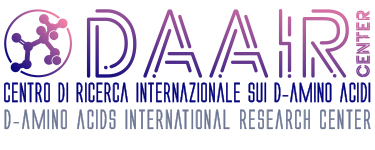
Do you have news concerning the D-amino acids field to announce? Is there a relevant published paper to mention? Write us and take the advantage of this bimonthly Newsletter.
The Editor’s pick selection of the most intriguing papers is highlighted in yellow.
We are proud to announce that prof. Loredano Pollegioni has been elected Treasurer and member of the Executive Committee of the International Union of Biochemistry and Molecular Biology!

D-AAs AND PHYSIOLOGY:
- D-Leucine protects oocytes from chronic psychological stress in mice
Ai Tsuji, Yuka Ikeda, Mutsumi Murakami, Yasuko Kitagishi, Satoru Matsuda
Reproductive Medicine and Biology 2021. https://doi.org/10.1002/rmb2.12396
Starting from the hypothesis that psychological stress could negatively influence female reproductive ability, D-leucine was examined as a protective agent on oocyte abnormality induced by such a stress. Female mice (6-week-old) were divided into three groups: control, restraint stress (RS), and RS fed with 0.3% D-Leu (RS/D-Leu). Oocyte maturation failure was increased in RS mice and D-Leu supplementation reduced abnormal oocytes to control level. Indeed, the expression levels of HO-1 and SOD2 antioxidant enzymes increased in RS/D-Leu mice compared to those of RS mice. The authors concluded that the D-Leu protection effect on oocytes from psychological stress is due to reduced oxidative stress by induction of HO-1 and SOD2 expression. MORE
- Novel Biomarkers of Alzheimer’s Disease: Based Upon N-methyl-D-aspartate Receptor Hypoactivation and Oxidative Stress
Chiang TI, Yu YH, Lin CH, Lane HY.
Clin Psychopharmacol Neurosci. 2021 Aug 31;19(3):423-433. doi: 10.9758/cpn.2021.
This review focuses on the relationships between the N-methyl-D-aspartate receptor and Alzheimer’s disease (AD), a very hot issue. The authors highlighted that sodium benzoate, a NMDA receptor enhancer and a well-known inhibitor of D-amino acid oxidase (the enzyme deputed to degradation of the receptor co-agonist D-serine) improved the cognitive and global function of patients with early-phase AD, that peripheral D-amino acid oxidase levels were higher in patients with Mild Cognitive Impairment and AD than healthy controls, and that sodium benzoate altered the activity of antioxidants. The authors propose that the NMDA receptor function is associated with anti-oxidation. MORE
D-AAs AND BACTERIA:
- Visualizing the Growth and Division of Rat Gut Bacteria by D-Amino Acid-Based in vivo Labeling and FISH Staining.
Chen R, Song J, Lin L, Liu J, Yang C, Wang W.
Front Mol Biosci. 2021 May 28;8:681938. doi: 10.3389/fmolb.2021.681938.
This paper aimed at characterizing the in situ growth and division of rat gut bacteria by using a chemical strategy that integrates the use of sequential tagging with D-amino acid-based metabolic probes (STAMP) with fluorescence in situ hybridization (FISH). Rats were fed sequentially with two different fluorescent D-amino acid probes: the resulting dually labeled gut bacteria provides chronological information about their in situ cell wall synthesis. The taxonomical labeling with FISH probes identified the growth patterns of 15 bacterial species, especially Butyrivibrio fibrisolvens. MORE
- D- and L-amino acid concentrations in culture broth of Lactobacillus are highly dependent on the phylogenetic group of Lactobacillus
Sugahara, H., Nagayama, K., Ikeda, S., Hirota, T., Nakamura, Y.
2021 Biochemistry and Biophysics Reports 27,101073. DOI 10.1016/j.bbrep.2021.101073.
D-amino acids produced by Lactobacillus are thought to contribute to the taste quality and health functions. Here, the concentrations of both the enantiomers of amino acids were determined in culture broth of Lactobacillus using a liquid chromatography-tandem mass spectrometry. Data analyses of 70 strains belonging to 17 Lactobacillus taxa indicated that the amino acids’ concentrations were highly dependent on the phylogenetic group and that the group differences in amino acid concentration were strongly driven by differences in L-serine and D-alanine concentrations: notably, the latter D-amino acid can affect taste quality. MORE
- Simultaneous Determination of D-amino Acids in Rat Urine by High-performance Liquid Chromatography-tandem Mass Spectrometry Method: Application to Investigate the Clinical Value of D-amino Acids in the Early Diagnosis of Alzheimer’s Disease.
Min Zhang, Shuting Zhang, Weichao Yu, Xiaoyan Li, Ning Ma and Yan Cui
Current Pharmaceutical Analysis 2021; 17(8). https://doi.org/10.2174/1573412916999200717235048.
Here, a novel HPLC/MS-MS method was developed for the determination of D-alanine, D-glutamine, D-proline and D-serine in rat urine. The samples, pretreated with methanol, were derivatized by 7-chloro-4-nitrobenzoxadiazole with Fudosteine (internal standard), separated on Sumichiral OA-2500S column, and detected with 4000 Qtrap MS/MS in electrospray-ionization source by negative ion mode. This approach was used to determine the levels of selected D-amino acids in rat urine from 20 Alzheimer’s disease (AD) rats and 20 age-matched normal controls. Notably, the mean levels of D-amino acids in the urine of AD rats were significantly lower than those in normal controls. MORE
- Enantiospecific Detection of D-Amino Acid through Synergistic Upconversion Energy Transfer
Xiaogang Liu, Yongan Tang, Xiaoyan Zhong, Shuangqian Yan, Xiaowang Liu, Yu Wang, Liang Cheng
Angewandte Chemie International Edition. 2021. DOI: 10.1002/anie.202105297.
This paper reports on an enzyme-coupled nanoprobe to detect D-amino acids through synergistic energy transfer. This nanoprobe offers near-infrared upconversion capability, a wide dynamic detection range, and a detection limit of 2.2 μM. This system allows in vivo, non-invasive detection of D-amino acids, potentially also in real-time in living animals. As an example, following subcutaneous injection of these nanoprobes into the back of mice, upconversion luminescence signals were positively related to D-serine doses in both imaging and emission intensity (although a quantification was not performed). MORE
- Enzymatic cascade systems for D-amino acid synthesis: progress and perspectives.
Fan, A., Li, J., Yu, Y., Nie X., Xu Y.
Syst Microbiol and Biomanuf (2021). https://doi.org/10.1007/s43393-021-00037-9
This review focuses on the enzymatic production of D-amino acids (widely used in foods, pharmaceuticals, and agricultural chemicals) to overcome the drawbacks associated with chemical synthesis. In particular, recent advances in multi-enzymatic cascade catalytic methods have been reported since this approach shows significant advantages (lower costs, no need for intermediate isolation, higher catalytic efficiency). MORE
- Ultrafast photoinduced electron transfer in o-aminobenzoate – D-amino acid oxidase complex
Seiji Taniguchi, Haik Chosrowjan, Haruhiko Tamaoki, Yasuzo Nishina, Arthit Nueangaudom, Fumio Tanaka
Journal of Photochemistry and Photobiology A: Chemistry, 16 July 2021, 113448 https://doi.org/10.1016/j.jphotochem.2021.113448
The absorption spectrum of the complex between o-amino benzoate (oAB) and D-amino acid oxidase shows a well-known charge transfer band at around 570 nm. Here, the fluorescence decays of the second lowest electronic state of the comlex were measured using a fluorescence up-conversion technique: the lifetimes were 100 fs and 130 fs at 500 nm and 514 nm fluorescence emission wavelengths, respectively. These ultrafast lifetimes are ascribed to the photoinduced electron transfer (PET) from the oAB to the excited isoalloxazine in the comlex. The PET mechanism in the complex was studied with Marcus-Kakitani-Mataga theory and the transition dynamics among local excited states of the isoalloxazine, the charge transfer state and the ion-pair state were discussed. MORE
The D-amino acids International Research Center “DAAIR“ has been established in Gerenzano (Varese, Italy) in 2019 with the aim to support and perform scientific research projects and activities on the field of D-amino acids. The Center, located inside the Fondazione Istituto Insubrico Ricerca per la Vita, is aimed to represent a pole of excellence at international level for dissemination and research involving the D-amino acids (Director Silvia Sacchi).
The guiding principle is support the research projects aimed to investigate the involvement of D-amino acids in main physiological processes, from bacteria to humans. The ultimate goal is to actively participate to the elucidation of the mechanisms by which the D-amino acids perform specific functions, and to identify their presence and concentration in different organisms and compartments, also with regards to well-established functional states, with particular emphasis to pathological states. Understand the involvement of D-amino acids in important diseases as a way to set up novel therapeutic strategies.
Contacts: info@d-aminoacids.com;
director@d-aminoacids.com;
www.d-aminoacids.com
https://www.d-aminoacids.com/
mailing address: info@d-aminoacids.com
Commenti recenti